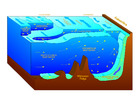- Meteotsunami
-
Some Locations Exposed to Meteotsunamis City Country Max Height (m) Nagasaki Bay Japan 4.8 Pohang Harbour Korea 0.8 Longkou Harbour China 3 Ciutadella Harbour Spain 4 Gulf of Trieste Italy 1.5 West Sicily Italy 1.5 Malta Malta 1 A meteotsunami or meteorological tsunami[1] is a tsunami-like wave phenomenon of meteorological origin. Tsunamis and meteotsunamis propagate in the water in the same way and have the same coastal dynamics. In other words, for an observer on the coast where it strikes the two types would look the same. The difference is in their source only. One definition of a meteotsunami is as an atmospherically generated large amplitude seiche oscillation.
The principal source of these tsunami-like ocean waves are travelling air pressure disturbances, including those associated with atmospheric gravity waves, roll clouds, pressure jumps, frontal passages, and squalls, which normally generate barotropic ocean waves in the open ocean and amplify them near the coast through specific resonance mechanisms. In contrast to "ordinary" impulse-type tsunami sources, a travelling atmospheric disturbance normally interacts with the ocean over a limited period of time (from several minutes to several hours).
These types of waves are common all over the world and are better known by their local names: rissaga (Catalan), milghuba (Maltese), marrobbio (Italian), abiki (Japanese).
See also
- Tsunami
- Historic tsunami
- Tsunami warning system (TWS)
- Deep-ocean Assessment and Reporting of Tsunamis (DART)
- Megatsunami
- Rip current
- Significant wave height
- Undular bore
References
- ^ Tsunami Glossary 2008, UNESCO
External links
- Presentation on meteotsunamis by the Croatian Institute for OceanographyPDF
- Photos of the Rissaga in Spain (Ciutadella) 06-15-2006
Categories:- Weather hazards
- Physical oceanography
- Flood
- Tsunami
- Water waves
Wikimedia Foundation. 2010.


